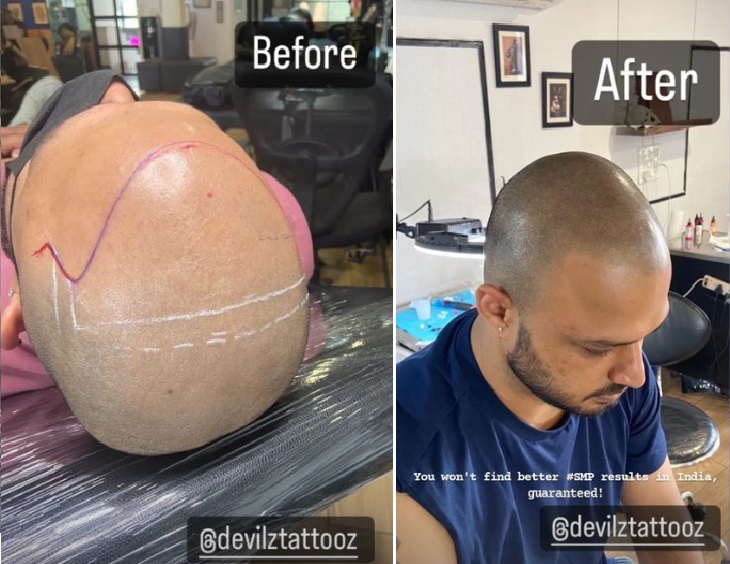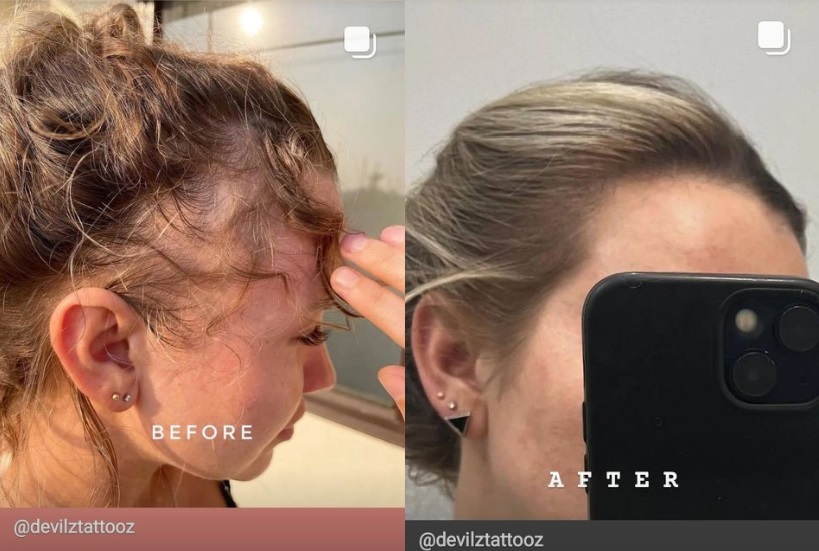Scalp Micropigmentation (SMP) For Women & Men
In recent years, scalp micropigmentation (SMP) has emerged as a revolutionary solution for both men and women facing hair loss or thinning hair. This innovative technique offers a non-invasive and long-lasting way to restore the appearance of a fuller head of hair, regardless of gender or age. Scalp micropigmentation for both men and women offers a life-changing solution who are struggling with hair loss or thinning hair. With its ability to create the illusion of a fuller head of hair, restore confidence, and deliver long-lasting results, SMP has become a popular choice for individuals of all ages and genders. Whether you're a man looking to redefine your hairline or a woman seeking to add density to thinning areas, scalp micropigmentation offers a customizable and effective solution to achieve the look you desire. With proper research, preparation, and aftercare, you can embark on a journey to a more confident and revitalized appearance with scalp micropigmentation.
Understanding Scalp Micropigmentation
Scalp micropigmentation is a cosmetic tattooing procedure that involves the application of specialized pigments to the scalp in a manner that mimics the appearance of hair follicles. This process creates the illusion of denser, thicker hair, camouflaging bald spots, receding hairlines, and even scars from hair transplant procedures. Unlike traditional tattooing, SMP uses microneedles to deposit pigment into the scalp's upper dermis layer, resulting in natural-looking results that can last for years. This is a safe non-invasive treatment suitable for all age groups male and females whether as young as 18 years or as old as 50 years. Now a days both male and females are opting for Scalp Micropigmentation depending on their needs.
Scalp Micropigmentation for Men
For men experiencing hair loss or thinning hair, scalp micropigmentation for men offers a transformative solution. Whether dealing with male pattern baldness, alopecia, or simply seeking to create a more defined hairline, SMP can provide a confidence-boosting appearance of a closely shaved head or a fuller hairline. With meticulous attention to detail, skilled SMP practitioners can customize the treatment to match the client's desired hairline shape, hair color, and density, ensuring a seamless and natural-looking result.
Scalp Micropigmentation for Women
While traditionally associated with male hair loss, scalp micropigmentation for women has gained popularity seeking to address hair thinning, alopecia, or uneven hairlines. For women, SMP can help create the illusion of denser hair, camouflage sparse areas, and restore confidence in their appearance. Whether looking to enhance the hairline, add density to thinning areas, or conceal scars from previous hair procedures, scalp micropigmentation offers a versatile solution for women of all ages.
Finding a Scalp Micropigmentation Provider
When considering scalp micropigmentation, it's essential to choose a reputable and experienced practitioner to achieve the best possible results. Before undergoing treatment, take the time to research different providers, read reviews, and view before and after photos of their work. Additionally, don't hesitate to schedule consultations with multiple practitioners to discuss your goals, expectations, and any concerns you may have.
Cost of Scalp Micropigmentation Treatment
The cost of scalp micropigmentation (SMP) treatment for both men and women can vary widely depending on several factors. Understanding these factors can help individuals gauge the potential cost of their SMP procedure and make informed decisions. Here are the key factors that determine the cost of SMP treatment:
- Treatment Area Size: The size of the treatment area also influences the cost of SMP treatment. Larger treatment areas, such as the entire scalp or significant portions of it, may require more time and resources, resulting in higher costs.
- Desired Outcome: The specific goals and desired outcome of the SMP treatment can impact the cost. For example, individuals looking to create a natural-looking hairline or add density to thinning areas may require more intricate and detailed work, which can affect the overall price.
- Number of Sessions: The number of SMP sessions required to achieve the desired results can vary depending on factors such as the individual's skin type, hair color, and the complexity of the treatment. Some individuals may achieve their desired results in a single session, while others may require multiple sessions spaced out over several weeks or months, each contributing to the total cost.
- Practitioner Expertise: The experience, skill level, and reputation of the SMP practitioner can impact the cost of treatment. Highly experienced and reputable practitioners may charge higher fees for their services, reflecting their expertise and the quality of results they can deliver.
- Geographic Location: The cost of SMP treatment can also vary depending on the geographic location of the clinic or practitioner. Treatment costs tend to be higher in major cities and urban areas where the cost of living and operating a business is typically higher.
- Clinic Facilities and Amenities: The quality of the clinic facilities, amenities, and equipment can also influence the cost of SMP treatment. Clinics offering state-of-the-art facilities, comfortable amenities, and advanced technology may charge higher fees to cover overhead expenses.
- Specialized Techniques or Customization: Specialized SMP techniques or customization options, such as custom hairline design, color blending, or scar camouflage, may incur additional costs. These personalized services cater to individual preferences and can enhance the overall results of the SMP treatment.
While the cost of SMP treatment can vary depending on these factors, it's essential for individuals to prioritize quality and expertise when choosing a practitioner or clinic. Investing in a reputable and experienced SMP practitioner can ensure optimal results and long-term satisfaction with the treatment outcome. Additionally, individuals should inquire about financing options or payment plans offered to make SMP treatment more accessible and affordable.
Looking to get an SMP treatment done! Book an appointment with us now…
Before & After: Transformative Results
One of the most compelling aspects of scalp micropigmentation is its ability to deliver dramatic before and after transformations. Whether it's restoring a receding hairline, concealing bald patches, or adding density to thinning areas, SMP can completely reshape a person's appearance and restore their confidence. Below are some stunning Scalp Micropigmentation before and after images showcasing the remarkable results:
Scalp Micropigmentation Treatment Aftercare
After undergoing scalp micropigmentation (SMP) treatment aftercare is essential to ensure optimal healing, longevity of results, and to minimize any potential complications. Whether you're a man or a woman, following these aftercare guidelines can help you achieve the best possible outcome:
- Keep the Scalp Clean and Dry:
- Gently cleanse the scalp with a mild, pH-balanced cleanser recommended by your SMP practitioner.
- Avoid using harsh or abrasive products that may irritate the scalp or affect the pigment.
- Pat the scalp dry with a clean, soft towel after cleansing, avoiding rubbing or scrubbing the treated area. - Avoid Sun Exposure:
- Protect the scalp from direct sunlight, as UV rays can fade the SMP pigment and cause irritation.
- Wear a hat when outdoors, especially during peak sun hours. - Avoid Excessive Sweating and Moisture:
- Refrain from activities that cause excessive sweating, such as intense exercise, sauna sessions, or steam baths, for at least one week post-treatment.
- Avoid swimming or submerging the scalp in water, including pools, hot tubs, and oceans, until the scalp has fully healed. - Avoid Scratching or Picking:
- Resist the urge to scratch, pick, or touch the treated area, as this can disrupt the healing process and affect the appearance of the SMP.
- If itching occurs, gently pat or tap the scalp instead of scratching to alleviate discomfort. - Moisturize the Scalp:
- Apply a gentle, fragrance-free moisturizer recommended by your SMP practitioner to keep the scalp hydrated and prevent dryness.
- Avoid moisturizers containing alcohol, fragrance, or harsh chemicals that may irritate the scalp or affect the SMP pigment. - Limit Hair Washing and Styling:
- Refrain from washing the hair or scalp for the first three to five days following SMP treatment, as excessive moisture can disrupt the healing process.
- After the initial healing period, use mild, sulfate-free shampoos and conditioners to cleanse the scalp, avoiding vigorous rubbing or scrubbing.
- Avoid using hair styling products or heat styling tools that may come into contact with the treated area, as these can affect the longevity of the SMP pigment. - Follow Post-Treatment Instructions:
- Adhere to any specific post-treatment instructions provided by your SMP practitioner, including recommended products, follow-up appointments, and activity restrictions.
- Attend scheduled follow-up appointments to monitor the healing process and address any concerns or questions you may have.
By following these aftercare guidelines, both men and women can promote healing, minimize discomfort, and ensure the success of their scalp micropigmentation treatment. However, remember to consult your SMP practitioner for personalized advice and recommendations based on your individual needs and circumstances. Understand that the full results of SMP treatment may take several weeks to fully manifest as the scalp heals and the pigment settles.Be patient and consistent with your aftercare routine, as with proper care and attention, SMP can provide natural-looking, long-lasting results that enhance confidence and restore a fuller, more youthful appearance to the scalp.
Visit our SMP Photo Gallery and FAQs sections for more information and results.

